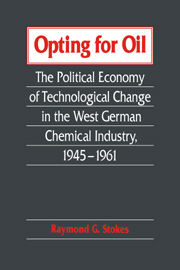Book contents
- Frontmatter
- Contents
- Preface
- Introduction
- Part I Background
- Part II Bargaining from strength: the political economy of technological change, 1949–1955
- Part III Alternative paths to plenty: case studies from the mid–1950s
- 5 Fifty-fifty with the petroleum multinationals: BASF, Shell, and Rheinische Olefinwerke
- 6 Fifty-fifty with the petroleum multinationals: Bayer, British Petroleum, and Erdölchemie
- 7 Going it alone: Hoechst
- 8 State's interest and technological change: Hüls and cold-rubber technology
- 9 End game strategies: the German coal industry and the Fischer-Tropsch process
- Part IV Consolidating the new regime, 1957–1961
- Index
6 - Fifty-fifty with the petroleum multinationals: Bayer, British Petroleum, and Erdölchemie
Published online by Cambridge University Press: 19 October 2009
- Frontmatter
- Contents
- Preface
- Introduction
- Part I Background
- Part II Bargaining from strength: the political economy of technological change, 1949–1955
- Part III Alternative paths to plenty: case studies from the mid–1950s
- 5 Fifty-fifty with the petroleum multinationals: BASF, Shell, and Rheinische Olefinwerke
- 6 Fifty-fifty with the petroleum multinationals: Bayer, British Petroleum, and Erdölchemie
- 7 Going it alone: Hoechst
- 8 State's interest and technological change: Hüls and cold-rubber technology
- 9 End game strategies: the German coal industry and the Fischer-Tropsch process
- Part IV Consolidating the new regime, 1957–1961
- Index
Summary
Farbenfabriken Bayer A.G., like BASF, has had a long and distinguished tradition of technical and commercial excellence within the international chemical industry. Prominent in the dyestuffs industry in the late nineteenth century, the company moved into pharmaceuticals at the end of the nineteenth century and the beginning of the twentieth. Carl Duisberg, one of the firm's leading chemists during that period, also proved to be an organizational innovator and an effective administrator. His plans for Bayer's Leverkusen facility, which remains the company's headquarters and an important manufacturing operation, constituted the first attempt at large-scale coordination of production, transportation, and other services in a single chemical plant that was also designed to accommodate the rapid and often unforeseen changes of the chemical industry. Duisberg's ideas about the need for coordinated financing, purchasing, research, and production in the German chemical industry, in order to meet the intense competition in foreign markets, were also behind the formation of I.G. Farbenindustrie A.G. Thus, it is no surprise that like BASF's Bosch, Duisberg and other Bayer managers played prominent roles in the new chemical giant. Duisberg himself became chairman of the I.G.'s supervisory board.
Bayer differed considerably from BASF, however, in terms of the primary source of its reputation and in the focus of its production. BASF's renown derived primarily from its technological expertise, whereas Bayer's reputation was based mostly on its commercial acumen.
- Type
- Chapter
- Information
- Opting for OilThe Political Economy of Technological Change in the West German Industry, 1945–1961, pp. 154 - 175Publisher: Cambridge University PressPrint publication year: 1994



